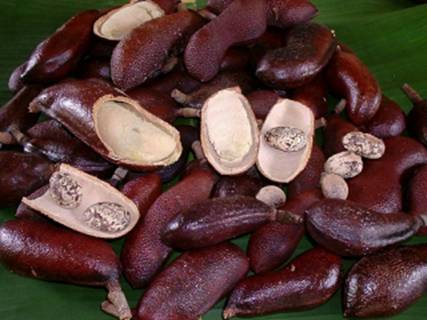
Hymenaea courbaril
POPULAR NAMES: Jatobá do mato, Jataiva and Jutaí-açú
FABACEAE - CAESALPINOIDEAE

INDIGENOUS NAME: Jatobá, comes from the Tupi and means "the fruit of hard shell."
Origin: Semideciduous forest (which lose their leaves in a time of year) of the Paraná River basin and the Atlantic Forest from Minas Gerais to Rio Grande do Sul and the Amazonas Forest land, Brazil.
Characteristics: Tree
with straight trunk and smooth gray bark, grows to
Planted in the site of Frutas Raras: November 2003, has not flourished yet.
Tips for growing: Tropical and subtropical plant that resist the frosts to -3°C (27°F), can be grown throughout the country, at every altitude; adapts to any type of soil, which drain the water well until the rain or sandy soils subject to flooding on the edge of rivers.
Propagation:
Seeds are dormant when dry,
when once planted, germinate in
Planting:
Can be planted in full sun
or reforestation mixed use for the wood, so you should plant a row of eucalyptus
and pine and a line of jatobá one year after the planting of the first that will
cause the plant grows upright, avoiding the dense branching when the plant is
grown in full
sun.
In the orchard plant in a space of 10 x 10 m (33 x 33 feet), water with
Cultivating:
Make only forming pruning of
the crown and remove branches that were grown from the base of the trunk if you
want to grow the tree or if you prefer to produce a rounded crown, can remove
the terminal bud and make pruning modeling every 2 years.
Fertilize with organic compost, can be (
Uses: The fruits of Jatobá is mealy and sweet pulp that can be consumed in-kind or used to make cakes, pies, jams etc.
Flowering in the site of Frutas Raras: Not yet occurred.
Fruiting in the site of Frutas Raras: Not yet occurred.
Back to the seedlist (English) or back to Fabaceae (Portuguese)